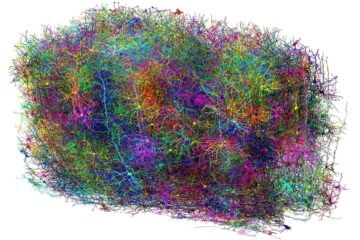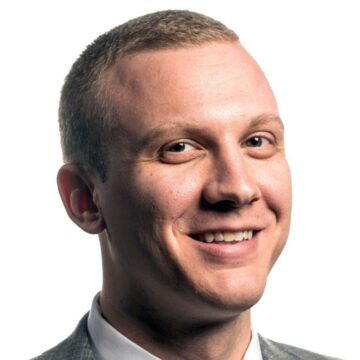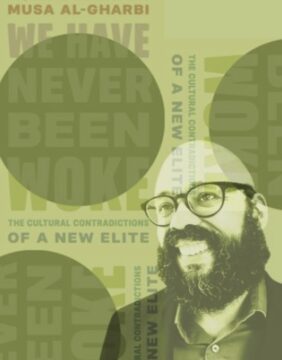Carl Zimmer in the New York Times:
 The human brain is so complex that scientific brains have a hard time making sense of it. A piece of neural tissue the size of a grain of sand might be packed with hundreds of thousands of cells linked together by miles of wiring. In 1979, Francis Crick, the Nobel-prize-winning scientist, concluded that the anatomy and activity in just a cubic millimeter of brain matter would forever exceed our understanding.
The human brain is so complex that scientific brains have a hard time making sense of it. A piece of neural tissue the size of a grain of sand might be packed with hundreds of thousands of cells linked together by miles of wiring. In 1979, Francis Crick, the Nobel-prize-winning scientist, concluded that the anatomy and activity in just a cubic millimeter of brain matter would forever exceed our understanding.
“It is no use asking for the impossible,” Dr. Crick wrote.
Forty-six years later, a team of more than 100 scientists has achieved that impossible, by recording the cellular activity and mapping the structure in a cubic millimeter of a mouse’s brain — less than one percent of its full volume. In accomplishing this feat, they amassed 1.6 petabytes of data — the equivalent of 22 years of nonstop high-definition video.
“This is a milestone,” said Davi Bock, a neuroscientist at the University of Vermont who was not involved in the study, which was published Wednesday in the journal Nature.
More here.
Enjoying the content on 3QD? Help keep us going by donating now.


 It’s a bit of a long story. In brief, I had always wanted to make a porn film. I thought it was a genre that had never been treated with much artfulness or experimentation. I mentioned this interest of mine online, and someone in the porn industry contacted me to say he could get a porn film by me financed and made. I asked him if there were any restrictions or rules, and he said I could write any kind of script I wanted. So I wrote a quite complicated, strange porn script, very explicit but more about eroticism and how that works than actually being erotic. The script turned out to be way too experimental to get financed. So that project died. Years later, a German film producer, Jurgen Bruening, heard about the script, asked to read it, and said he might be interested in producing it. I was collaborating with Zac Farley on other projects by then. I asked if he was interested in working with me, and he agreed. We rewrote the script, taking out most of the actual hardcore porn, and submitted it. Jurgen Bruening liked the script and produced the film for very ittle money, $40,000. So we made Like Cattle Towards Glow. Neither Zac nor I had ever made a film before, but we saw it as a kind of strange, shot-in-the-dark experiment to see what would happen, and it worked out strangely well.
It’s a bit of a long story. In brief, I had always wanted to make a porn film. I thought it was a genre that had never been treated with much artfulness or experimentation. I mentioned this interest of mine online, and someone in the porn industry contacted me to say he could get a porn film by me financed and made. I asked him if there were any restrictions or rules, and he said I could write any kind of script I wanted. So I wrote a quite complicated, strange porn script, very explicit but more about eroticism and how that works than actually being erotic. The script turned out to be way too experimental to get financed. So that project died. Years later, a German film producer, Jurgen Bruening, heard about the script, asked to read it, and said he might be interested in producing it. I was collaborating with Zac Farley on other projects by then. I asked if he was interested in working with me, and he agreed. We rewrote the script, taking out most of the actual hardcore porn, and submitted it. Jurgen Bruening liked the script and produced the film for very ittle money, $40,000. So we made Like Cattle Towards Glow. Neither Zac nor I had ever made a film before, but we saw it as a kind of strange, shot-in-the-dark experiment to see what would happen, and it worked out strangely well. A lot of what comes in William Blake and the Sea Monsters of Love is about fellow enthusiasts rather than about Blake himself. It opens with Derek Jarman at the Avebury stone circle, treading in the footsteps of Paul Nash; then, by what Coleridge called the ‘streamy nature of association’, we follow Nash on his first trip to London in 1906, where, at the Carfax gallery, he saw an exhibition of Blake’s pictures. These moved him greatly – or, as Hoare puts it, ‘A crack in the sky opened up and a hand reached down.’ Another cut then takes us to John Singer Sargent in 1894 painting his memorable portrait of W Graham Robertson, who later illustrated a book called Pan’s Garden by his friend Algernon Blackwood, who purchased a great collection of Blake’s pictures from the family of his devoted patron Thomas Butts. Those were the paintings displayed in the Carfax gallery. As Nash looked at them, says Hoare, he saw ‘the god behind the machine’ – the machine in question being the modern industrial world of ‘science and rationalism’, that familiar bogey whom we can all deplore while enjoying its many benefits.
A lot of what comes in William Blake and the Sea Monsters of Love is about fellow enthusiasts rather than about Blake himself. It opens with Derek Jarman at the Avebury stone circle, treading in the footsteps of Paul Nash; then, by what Coleridge called the ‘streamy nature of association’, we follow Nash on his first trip to London in 1906, where, at the Carfax gallery, he saw an exhibition of Blake’s pictures. These moved him greatly – or, as Hoare puts it, ‘A crack in the sky opened up and a hand reached down.’ Another cut then takes us to John Singer Sargent in 1894 painting his memorable portrait of W Graham Robertson, who later illustrated a book called Pan’s Garden by his friend Algernon Blackwood, who purchased a great collection of Blake’s pictures from the family of his devoted patron Thomas Butts. Those were the paintings displayed in the Carfax gallery. As Nash looked at them, says Hoare, he saw ‘the god behind the machine’ – the machine in question being the modern industrial world of ‘science and rationalism’, that familiar bogey whom we can all deplore while enjoying its many benefits. It sounds like a strategy meeting with the campaign team: “Whom do men say that I am?”
It sounds like a strategy meeting with the campaign team: “Whom do men say that I am?” The words we use feel inevitable. We take them for granted. But they began life about 6,000 years ago, when copper was being smithed in the lands to the west of the Black Sea. Spinney says “an aura of magic must have hovered around the early smiths, who drew this gleaming marvel from blue-green rock”. New language hovered around them, too.
The words we use feel inevitable. We take them for granted. But they began life about 6,000 years ago, when copper was being smithed in the lands to the west of the Black Sea. Spinney says “an aura of magic must have hovered around the early smiths, who drew this gleaming marvel from blue-green rock”. New language hovered around them, too. Science has a trust problem — at least, that is the common perception. If only, the argument goes, we could get people to ‘trust’ or ‘follow’ the science, we, as a society, would be doing more about climate change, childhood vaccination rates would be increasing rather than decreasing and fewer people would have died during the COVID-19 pandemic. Characterizing the problem as ‘science denialism’, however, is misleading and wrongly suggests that the solution is to build greater trust between scientists and the public.
Science has a trust problem — at least, that is the common perception. If only, the argument goes, we could get people to ‘trust’ or ‘follow’ the science, we, as a society, would be doing more about climate change, childhood vaccination rates would be increasing rather than decreasing and fewer people would have died during the COVID-19 pandemic. Characterizing the problem as ‘science denialism’, however, is misleading and wrongly suggests that the solution is to build greater trust between scientists and the public. “What if we view street activities not as organic, evolving phenomena but as calculated efforts to challenge and subvert the state rules governing street dynamics?” Pamela Karimi asks in
“What if we view street activities not as organic, evolving phenomena but as calculated efforts to challenge and subvert the state rules governing street dynamics?” Pamela Karimi asks in  O
O A
A On March 19, 2024, we emailed the psychologist and Nobel laureate Daniel Kahneman, inviting him to appear on our podcast, “Lives Well Lived,” and suggesting a date in May. He replied promptly, saying that he would not be available then because he was on his way to Switzerland, where, despite being relatively healthy at 90, he planned to die by assisted suicide on March 27.
On March 19, 2024, we emailed the psychologist and Nobel laureate Daniel Kahneman, inviting him to appear on our podcast, “Lives Well Lived,” and suggesting a date in May. He replied promptly, saying that he would not be available then because he was on his way to Switzerland, where, despite being relatively healthy at 90, he planned to die by assisted suicide on March 27. Today’s AI technologies are based on deep learning, yet “AI” is commonly equated with large language models, and the fundamental nature of deep learning and LLMs is obscured by talk of using “statistical patterns” to “predict tokens”. This token-focused framing has been a remarkably effective way to misunderstand AI.
Today’s AI technologies are based on deep learning, yet “AI” is commonly equated with large language models, and the fundamental nature of deep learning and LLMs is obscured by talk of using “statistical patterns” to “predict tokens”. This token-focused framing has been a remarkably effective way to misunderstand AI. In recent decades, a paradox has haunted American political life. Given that political progressives wielded considerable political, economic, and cultural influence, how is it possible that our actual social order was so resistant to real change? Why did the black-white wealth gap remain unchanged, and why did economic inequality steadily increase? Why did basic access to affordable housing plummet? And why has higher education become a nightmarish debt sentence for poor and underprivileged people seeking a better life?
In recent decades, a paradox has haunted American political life. Given that political progressives wielded considerable political, economic, and cultural influence, how is it possible that our actual social order was so resistant to real change? Why did the black-white wealth gap remain unchanged, and why did economic inequality steadily increase? Why did basic access to affordable housing plummet? And why has higher education become a nightmarish debt sentence for poor and underprivileged people seeking a better life?